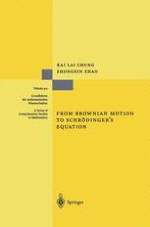1995 | OriginalPaper | Buchkapitel
Stopped Feynman-Kac Functional
verfasst von : Kai Lai Chung, Zhongxin Zhao
Erschienen in: From Brownian Motion to Schrödinger’s Equation
Verlag: Springer Berlin Heidelberg
Enthalten in: Professional Book Archive
Aktivieren Sie unsere intelligente Suche, um passende Fachinhalte oder Patente zu finden.
Wählen Sie Textabschnitte aus um mit Künstlicher Intelligenz passenden Patente zu finden. powered by
Markieren Sie Textabschnitte, um KI-gestützt weitere passende Inhalte zu finden. powered by
Let D be a domain in ℝd, and for a function q ∈ βd, let $$ e_q (\tau _\mathcal{D} ) = \exp (\int_0^{\tau _\mathcal{D} } {q(X_t )dt} ), $$ where {X t} is the Brownian motion in ℝd, and τD is the exit time from D defined in Section 1.5. The random variable in (1) is well defined if and only if $$ \int_0^{\tau _\mathcal{D} } q (X_t )dt $$ is well defined, almost surely. This is trivially the case if q ∈ 0, or if q is bounded and τD < ∞. To see that this is also the case when q ∈ J and τD < ∞, we need the Corollary to Proposition 3.8 which implies that for each t > 0, $$ \int_0^t {\left| q \right.(X_s )\left| {ds < \infty } \right.} $$ a.s.; thus, the same is true when t is replaced by τD provided the latter is finite a.s. As before, ‘a.s.’ will be omitted in what follows when the context is obvious. Under these circumstances we have 0 < eq (τD) < ∞; and in fact for each x ∈ ℝd , if Px{τD < ∞} > 0, then $$ 0 < E^x \left\{ {\tau _\mathcal{D} < \infty ;e_q (\tau _\mathcal{D} )} \right\} \leqslant \infty . $$
